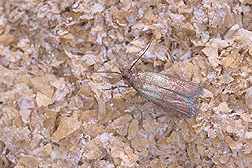This page has been archived and is being provided for reference purposes only. The page is no longer being updated, and therefore, links on the page may be invalid.
|
|
New Method Monitors Insects Ravaging Stored Products
By Jim CoreNovember 30, 2005
Food processors, warehouse managers and store retailers have a big economic interest in keeping pests at bay. That's why Agricultural Research Service scientists have developed a method to keep insects such as moths, beetles and their larvae from damaging and contaminating stored products.
ARS scientists at the Center for Medical, Agricultural and Veterinary Entomology (CMAVE) in Gainesville, Fla., developed a new monitoring method using a combination of trapping and spatial analysis to locate infestations. Spatial analysis procedures establish the relationship between the number of insects trapped in a specific time period and their proximity to the infestation source.
After entering data into a computer about the number of insects caught in traps from specific points, scientists use spatial analysis to construct contour maps identifying the insect population centers that need treatment. These easily understood graphic maps are used to document the number of pests and their movements, and to communicate the effectiveness of control measures to maintenance, sanitation and pest control personnel.
Richard Arbogast, an entomologist at CMAVE's Chemistry Research Unit, developed the method with collaborators including ARS entomologist Paul E. Kendra of the Subtropical Horticulture Research Station in Miami, Fla., and Jeffrey E. McGovern of Orkin Commercial Division in Atlanta, Ga.
Pest management usually relies on chemical insecticides and fumigants to keep insects away from a variety of products including grains and cereals, nuts, dried fruits and botanicals. Most pest control operators typically focus on when and where they expect pests to be found. This method gives them an additional tool to help zero in on infestations, often in unexpected places, according to Arbogast.
Contour maps eliminate the need for routine preventive treatment. This reduces the area that needs to be exposed to pesticides and facilitates non-chemical approaches.
The method has been tested in various commercial settings and found to be effective. It has been well received by the pest control and food processing industries, and interest is expected to expand.
ARS is the U.S. Department of Agriculture's chief scientific research agency.

